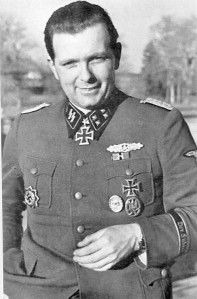Helmut fights
Helmut Kampf (born July 31, 1909 , † June 9 or 10, 1944 ) was a Sturmbannführer in the Waffen-SS during the Second World War .
Life
Kampf was the son of a printer and was drafted with the start of World War II. He volunteered for the SS disposable troops . From 1934 to August 1939 he was deployed as a reserve lieutenant in the 102nd Infantry Regiment. In the meantime he was a teacher with the 7th Rifle Regiment.
He was taken over as SS-Unterscharführer in the SS-Einsatzstruppe and took part in the western campaign as commander of an infantry company of the SS-Lieferstruppe in 1940 . At the end of January 1941, following the success of his company on the Grebbe Line , in Flanders , Reims and Bordeaux, he was appointed SS-Obersturmführer . As a company commander, he first switched to SS-Totenkopf-Standarte 14 and a short time later was transferred to the 2nd (motorbike) reconnaissance department of the 2nd SS Panzer Division "Das Reich" . At the end of 1941 he was awarded the Iron Cross, First Class, and was wounded and did not serve at the front until January 1942. Then he took over the company again and fought on the Vyazma Front.
Fights was awarded the Knight's Cross of the Iron Cross on December 10, 1943 for services on the Eastern Front . B. in the Battle of the Dnepr . Probably in December 1943 he and his division, the 2nd SS Panzer Division "Das Reich", were relocated to south-west France, where in 1944 he became commander of the III. Battalion of the SS Panzer Grenadier Regiment 4 "Der Führer" was.
To combat the Allied landing forces in Normandy , the division was ordered to travel north about 700 km. Due to acts of sabotage against railway lines, the armored vehicles also had to advance on their own axis. On June 9, 1944, parts of the division reached the city of Tulle , which had previously been occupied by the Germans and which had been captured the day before by the communist-ruled FTP with German losses. On the same day, the division "Das Reich" recaptured the city and retaliated against the German population in the so-called Tulle massacre . 99 French were hanged by members of the division.
At the same time, fighting on the German side was considered missing. He was already driving a car around 100 km further north. His car had been found abandoned and search measures immediately initiated did not lead to any result. Fighting had fallen into the hands of the French resistance. First he was brought to Cheissoux and during the night via Limoges to Breuilaufa . In response to the Tulle massacre, fighting and other captured Wehrmacht soldiers were burned alive in a hijacked German military ambulance. Peter Lieb states that Fampf was shot. As with the type of death, there are different variants of the trigger for the following massacre.
After the SS division learned of the death of Kämpfes, his longtime comrade in arms and friend, Adolf Dieckmann , as commander of the 1st battalion of SS Panzer Grenadier Regiment 4 "Der Führer", decided to retaliate. Whether Dieckmann planned the complete destruction of the village or just wanted to take hostages; 30 people are reported; cannot be determined. Diekmann had learned that fighting was probably being held in a place called Oradour . Since there were five possible places in the vicinity, he decided on the village of Oradour-sur-Glane . In the following Oradour massacre , 642 men, women and children were murdered and the entire place was destroyed.
Kämfe's remains were initially buried anonymously in Breuilaufa. According to the findings of the German War Graves Commission , the remains were reburied in the military cemetery in Berneuil in 1963 .
literature
- Florian Berger: The Face of Courage . Stackpole Books, 2011, p. 219 ff.
Web links
- Did a mix-up lead to the destruction of Oradour? World , June 10, 2014
Individual evidence
- ↑ Peter Lieb: Conventional War or Nazi Weltanschauungskrieg ?: Warfare and Fight against Partisans in France 1943/44 . Walter de Gruyter, 2012, ISBN 978-3-486-70741-0 , p. 116 ( google.de [accessed on August 9, 2020]).
- ↑ Fights on www.oradour.info (English).
- ^ Samuel W. Mitcham: Defenders of Fortress Europe: The Untold Story of the German Officers During the Allied Invasion . Potomac Books, Inc., 2009, ISBN 978-1-59797-274-1 , pp. 66 ( google.co.uk [accessed August 9, 2020]).
- ↑ Augsburger Allgemeine: My father, the war criminal. Retrieved August 9, 2020 .
- ↑ Peter Lieb: Conventional War or Nazi Weltanschauungskrieg ?: Warfare and Fight against Partisans in France 1943/44 . Walter de Gruyter, 2012, ISBN 978-3-486-70741-0 , p. 369 ( google.de [accessed on August 9, 2020]).
- ^ Grave of Helmut Kampf in Berneuil at oradour.info.
| personal data | |
|---|---|
| SURNAME | Fight, Helmut |
| BRIEF DESCRIPTION | German Sturmbannführer of the Waffen SS |
| DATE OF BIRTH | July 31, 1909 |
| DATE OF DEATH | uncertain: June 9, 1944 or June 10, 1944 |
